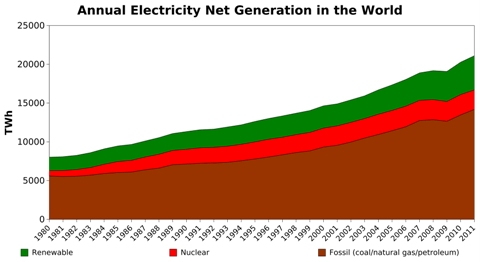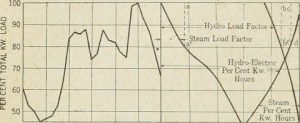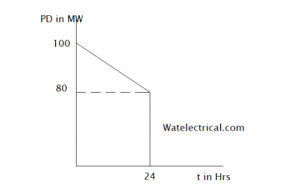At present, everything is dependent on electricity from mobile phones to every electronic device used in daily. Because day by day the demand for electricity is increasing and there are efficient and better ways are available for generating electricity through Power Plants. The electricity usage can be observed annually in a 24-hour format & the demand for peak load can be noted to examine. Because of doubtful demands by the consumer regarding power, the sum of load on the power plant changes frequently. For an instant, in the summer season, the electricity demand increases hugely like everyone uses AC (air conditioning) units. However, in the winter season that demand will be less because AC units are not used frequently. Apart from the demand, different kinds of power sources must be capable to meet the necessities immediately.
What is the Load Factor?
- It is an indicator to understand the demand over a period of time. It is indicated by observing the amount of electrical energy utilized over a period of time.
- The electrical energy produced should meet the required demand of consumers. To satisfy the requirement, power stations are classified as baseload and peak load power stations. Baseload power stations are Thermal, and Nuclear. Peak load power stations are Hydel, and Diesel power stations.
- During the normal supply, the baseload power plants satisfy the required demand. But during peak loads, the power supplied by the baseload power plants is not sufficient to meet the demand. So, peak load power plants I,e Hydel or Diesel power stations operate quickly in order to meet the peak demand during peak loads. The drawback of peak load plants is, the construction cost of peak load plants requires a huge investment.
- The average annual net electricity generation in the world with respect to different available sources such as Renewable, Nuclear, and Fossil fuels their generation over some period with time are plotted as a curve as shown in the figure.

Annual-Net-Generation
Definition
The load factor is defined as the proportion of average demand to the maximum demand.
Formula
Load factor = Average demand/maximum demand. The figure gives the data of peak demand observed during a 24-hour duration by comparing power in KW with respect to time in hours.

24-hour Load Graph
- The average demand is the average of total load in a 24-hour duration.
- Average demand = No of units consumed/Total no of hours in a given period.
- The maximum demand is the peak load observed on a 24-hour duration.
- Average demand is less than maximum demand.
- This is always less than one.
- No of Units = Average demand * T (total no of hours)
- As this factor increases, average demand Increases, No of units increases and revenue also increases.
The load factor is given as electrical energy consumption in KWh / Peak demand * no of hours in a given period.
Importance
- This plays a key role in meeting the peak demand of consumers at all times.
- It mainly affects the revenue of the power plant.
- If this increases, the revenue of the power plant increases.
How to Improve Load factor
- This can be improved by lowering peak demand. Peak demand is analyzed by observing the monthly billing. The maximum demand is observed during the summer season. Customers can decrease the load factor by decreasing the peak demand observed during the previous month.
- The periodical observation of peak demand from monthly billing can be used to decrease the peak demand.
- The same amount of electricity can be utilized for two months with different peak demands. Since the average cost per unit consumption differs during peak demand.
Methods to be Implemented to Improve LF
The load factor results in a decrease or increase in peak demand and the cost of the power plant. If peak demand is decreased the load factor will increase and the cost of the power plant will decrease. Similarly, if peak demand is increased the load factor will decrease and the cost of the power plant will increase.
Offering Subsidies to Farmers
- Offer farmers to use their high rated motors during the non-peak period such that we can reduce the peak demand.
Offering Subsidies to Industries
- Offer subsidy by reducing the electrical energy consumption per unit during the non-peak periods. Encouraging Industrial consumers to run their equipment during this period can reduce the peak demand.
Utilization of Sunlight
- By effective utilization of sunlight, we can reduce the peak demand.
By Following Two-part Tariff
The tariff is the price per unit of electrical energy consumed. We should follow two tariff’s such as non-peak time should be charged with less unit rate compared to the peak time. By this, the consumption of energy during the time will decrease. Say, if non-peak time is charged at Rs 5 per unit then, the peak time should be charged at the higher unit rate than the non-peak time I,e Rs 6 per unit.
Please refer to this link for Load Factor MCQs.
Load Factor Calculation Examples
The monthly electrical energy consumption of an industry is 18000Kwh and the maximum demand is 50KWh. Calculate the Load factor?
The formula is electrical energy consumption in KWh / Peak demand * no of hours in a given period
Load factor = 18000 KWh / 50 KW * 30days * 24 hours
= 18000 KWh / 36000 KWh
= 0.5
From the above calculation, we can notice that consumers utilized (18000KWh) of the total energy available (36000KWh) which is 50%.
The LF of the power system is shown below. Calculate the Load factor?

Example
LF = Average demand/ Maximum demand
Average demand = No of units consumed /Total no of hours in a given period.
= 80 * 24 + 0.5 * 24 * 20
=1920 + 240
= 2160
Load factor = (2160/240)/(100) = 90/100 = 0.9
Therefore, it can be concluded that in a practical power system, the load factor should be as high as possible in order to decrease the cost of the plant. In this article, we had an overview of what is Load factor, the formula for finding the load factor. Apart from this, we have also studied different cases of finding the load factor. Here is a question for the readers, what is Diversity factor?